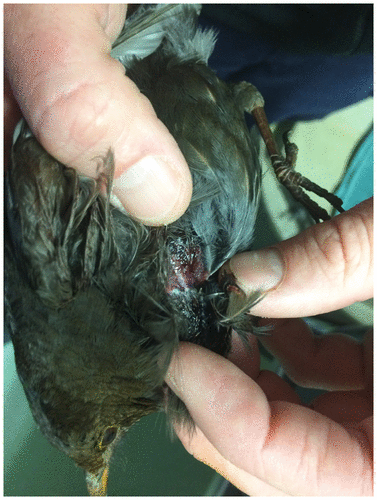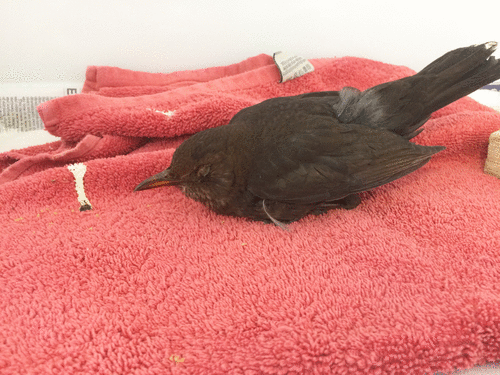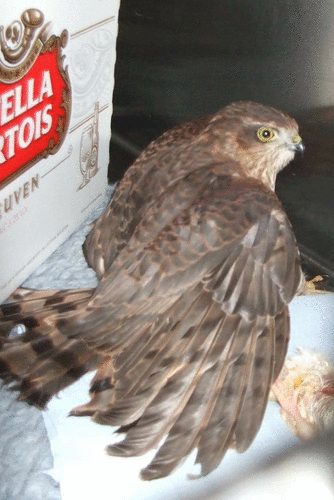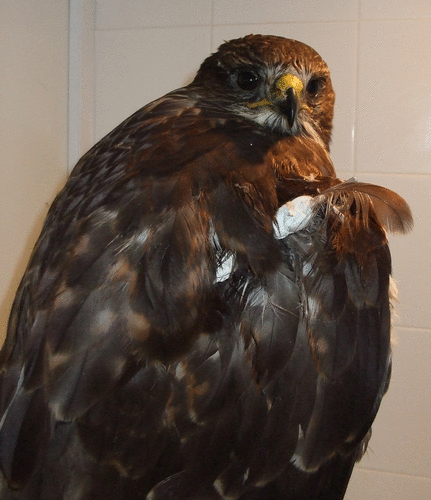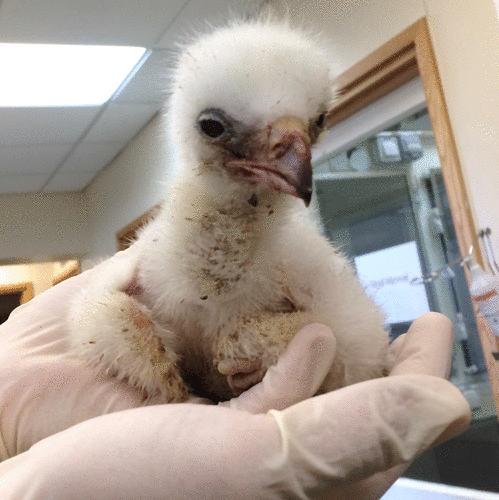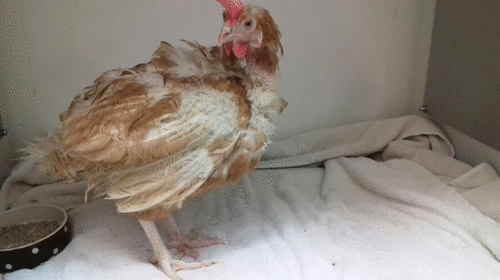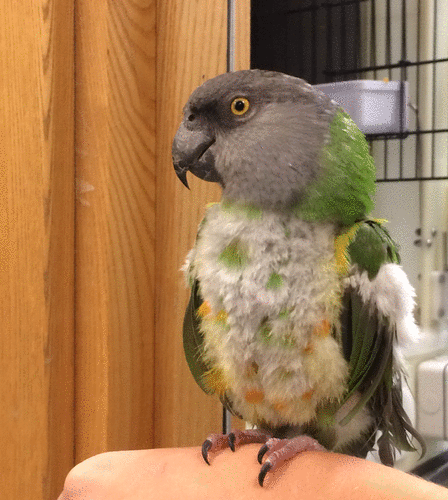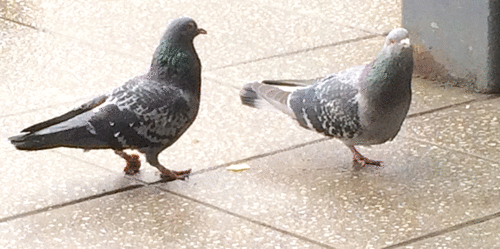Abstract
Pain assessment and management in animals is still a new and growing field of research. Although it is still early days for pain research in birds, this article aims to provide information on the pain behaviours known so far, and describes current analgesic drugs and doses.
Keywords:
Introduction
There is a need to develop valid and reliable techniques for the assessment of pain (Weary, Niel, Flower, & Fraser, Citation2006), because it is difficult to say if we have effectively treated something if we cannot measure it before and after therapy (Paul-Murphy, Citation2006).
As avian pain assessment and management is still in the early stages, it is very likely that our avian patients in practice are still undertreated for pain (Hawkins, Citation2006, Kubiak, Citation2016a).
Blackbird with cat bite injuries and thoracic puncture. Note the hunched appearance typical of this condition. Photo courtesy of Vale Wildlife Hospital.
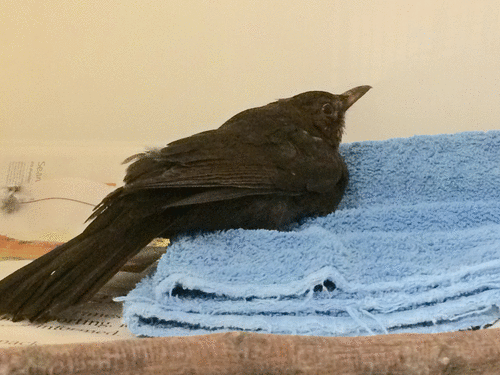
The reasons why pain often goes untreated have been discussed previously. Briefly, practitioners can overestimate the risk of potential side effects, worry about masking symptoms and the cost to the owner. Unfortunately, practitioners subconsciously assign a “moral status” to a patient that decides whether the animal is worth analgesia – for example, is it a wild pigeon or an expensive owned falcon?
In addition, the benefit of analgesia to the welfare of the patient can be underestimated (see Bradbury, cited in White, Citation2016). Whether a practitioner acknowledges animal pain and their tendency to act on it depends on their level of empathy, which varies for many personal, societal and cultural reasons. Finally, without knowing the normal behaviour of a species, an observer will find it extremely difficult to detect abnormal behaviour, especially in prey species (Paul-Murphy & Hawkins, Citation2015).
This is the same patient, with an air sac visible due to thoracic puncture. This presentation, along with the cat bite injury, would have been very painful to the bird and would warrant analgesia. Photo Courtesy of Vale Wildlife Hospital.
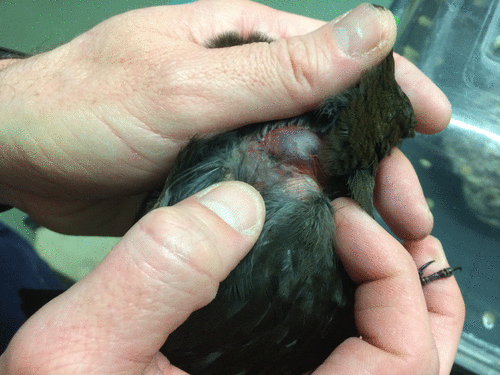
Pain is described by people as “one of the most negative experiences possible” (Mellor & Bayvel, Citation2011). Pain has both physical and emotional effects. We are also aware that pain is a debilitating factor in healing. Relief of pain in birds has demonstrated a quicker return to recovery (Paul-Murphy, Citation2006 unpublished data; Forbes, Citation1999.
The pain experience is considered analogous to that of mammals (Kubiak, Citation2016a; Machin, Citation2005). Therefore, pain is a significant factor in any medical condition or traumatic injury that may be painful to us, despite the differences in expressive pain behaviours between birds and mammals.
Young collared dove with cat injuries to back, right leg and tail feathers. Large feathers pulled out are extremely painful. This bird was started on a course of meloxicam, antibiotics and wound flushes. Initially it was not eating therefore required crop feeding. Photo courtesy of Vale Wildlife Hospital.
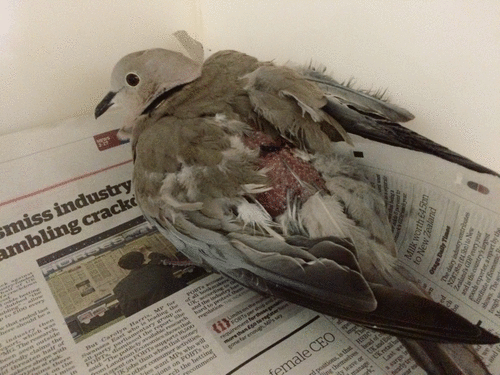
Painful conditions in pet birds
Pet birds often present with problems such as respiratory, gastrointestinal (GI) or reproductive disease. Infectious or external environmental agents are often a cause. Full history-taking, husbandry information and thorough diagnostic work-ups in these cases are essential to determine and treat the underlying problem, and analgesia is often important in the treatment. Husbandry-related issues are frequent. Egg-binding, GI or respiratory conditions caused by inappropriate diet or environment and feather-destructive behaviour are all conditions that have potential to cause some discomfort or pain.
It is important to attempt to understand the normal behaviour of the individual as well as the species. Questioning the owner will help a great deal with this. Observant owners, vets, animal care staff and nurses will be able to pick up on behavioural changes associated with pain (Hawkins & Paul-Murphy, Citation2011). If a pet bird is hospitalised, finding out from the owners their level of sociability and preferences for human contact or enrichment will help speed their recovery.
Painful conditions in wild birds
The avian patients that we as veterinary nurses probably see the most are cat-caught wild birds and road traffic accidents. Figures estimate that 55 million wild birds are brought home by cats every year in the UK (RSPB, Citation2017 data) – and these are just birds brought home, not killed or injured, or accounting for subsequent deaths from failed nests if a parent bird was taken. This is probably a major underestimation.
Tawny owl with a superficial corneal ulcer. Eye ulcers often warrant systemic as well as topical analgesia (courtesy of Adina Valentine)
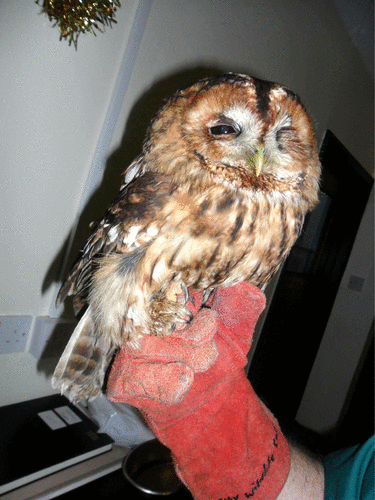
Wild birds often present to us with traumatic injuries, such as bone fractures, head traumas or bite wounds.
Buzzard with an oral trauma, that progressed to an abscess. Any sizeable abscess is a painful condition and would warrant pain relief (courtesy of Adina Valentine)
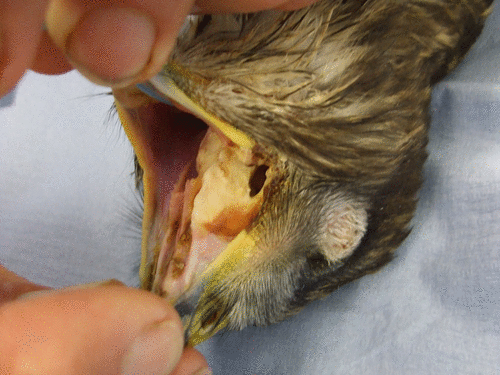
It is very difficult for us to detect pain in wild birds. Birds are often prey species and will act as such: a debilitated bird in the wild will do its utmost to appear healthy to avoid predation, or ensure its territory is not encroached on. Likewise, avian predator species will also do everything they can to appear normal. We should be mindful of this during initial examination, and ensure that our approach to observation is adequate: this may mean we have to observe the hospitalised bird from a distance initially, rather than directly observing them.
It is difficult in this case to ascertain whether this behaviour is caused by general debilitation, or pain, until diagnosis. The pigeon was diagnosed with Trichomoniasis, or ‘mouth canker’. The patient was in early stages of shock, due to being weak, dehydrated and hypothermic from having been unable to eat for so long. So the fluffed up appearance and lethargic behaviour could be a result of the illness, but there might also be potential for some oral discomfort. Photo courtesy of Vale Wildlife Hospital.
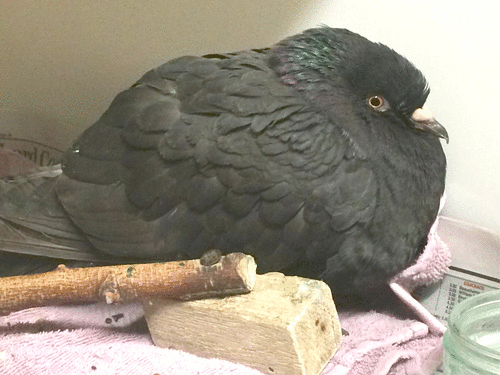
It goes without saying that normal nursing care as for any bird, such as the provision of a clean, warm, dry, quiet cage away from predators, with appropriate and suitably positioned perches, a comfortable bed, easily accessible provisions and quiet, gentle and efficient handling will go a long way in increasing patient comfort (Machin, Citation2014).
This young kestrel presented with hypersalivation and neurological signs. It was started on butorphanol as an analgesic just in case there was any gastro-intestinal pain or discomfort due to ingestion of a potentially toxic substance.
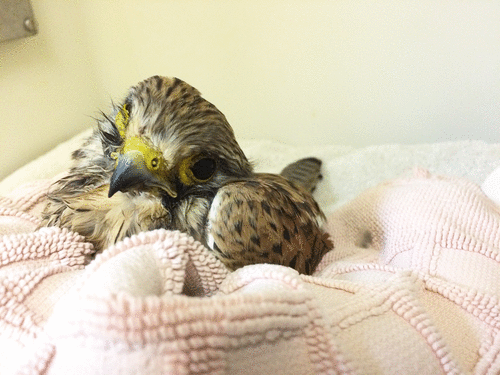
In pet birds and wild birds, treatments such as fluid therapy, injections or crop feeding should be grouped together as far as possible to avoid repeated interruption and handling and to minimise stress.
Painful conditions in farmed birds
In terms of numbers, farming is by far the biggest issue concerning avian pain.
Bumble foot is a common painful condition in farmed birds. With kind permission from the British Hen Welfare Trust
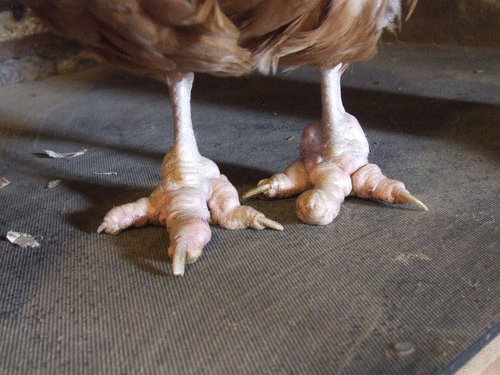
Both the layer hen industry and broiler (meat chicken) industry have numerous routine practices (such as de-beaking or de-spurring) done on conscious birds in the absence of pain relief. Harvesting, transport, lairage and slaughter are all major events in the life of a farmed bird with potential and evidence for major injury (such as getting stuck or caught).
Cloacal prolapse is a common painful condition in farmed laying hens. With kind permission from the British Hen Welfare Trust
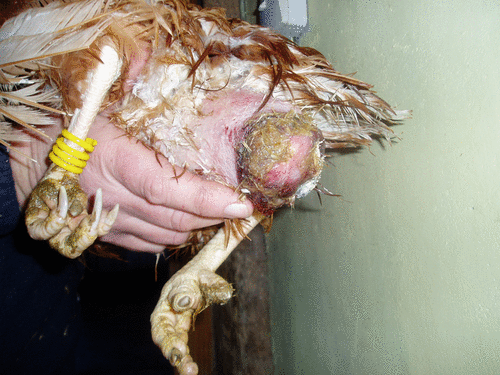
The main acquired painful conditions are bone fractures in the layer hen industry and chronic leg pain in the broiler industry. Farmed birds are the only animals in the UK shackled upside down prior to stunning, and the evidence for chronic leg pain among broilers questions whether this is an appropriate kill method (Wathes, Citation2009).
The difficulty in this photo is differentiating between pain and anaesthetic recovery. This is an ex- battery hen post right femoral fracture repair surgery. However given that chickens rarely show outward signs of pain and do their best to pretend they are normal, and this bird had been extubated two hours prior to this photo and was minimally responsive to stimulus, the decision was to increase the frequency of the analgesia post op.
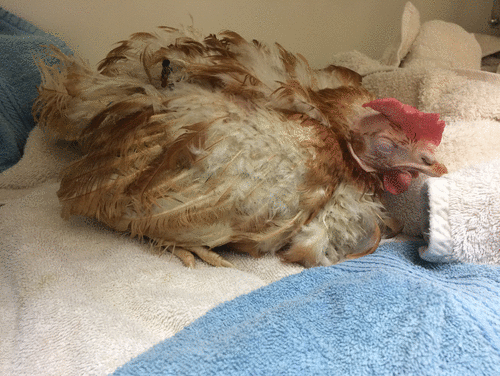
A note on laboratory birds
In animal research, birds represent a fairly small proportion of the animals used – in 2016, there were 2.02 million experimental procedures carried out in the UK. Around 150,000 (or 7%) of these procedures involved birds. They are used for a variety of experiments, but limited in comparison to, for example, rodents (Home Office Data, Citation2016). The author has found information for laboratory bird experimentation difficult to access.
Pain behaviours
Research in avian pain is limited, but much of it comes from welfare science with a concern for routine farming practices. Much of the research in Table looks at pain behaviours in farmed birds, but it is likely to be applicable in many ways to birds we see in practice.
Table 1. Table of pain studies in birds
Chicken showing signs of pain following a cloacal prolapse. She was administered tramadol and a cold compress, and following fluid therapy, meloxicam.
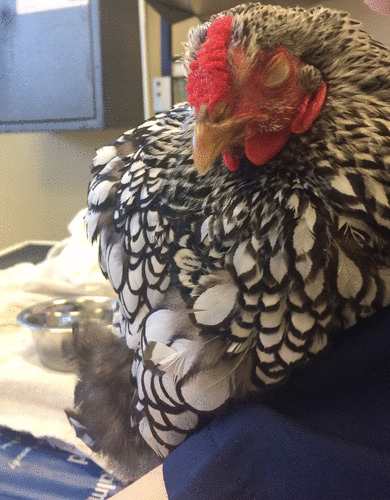
When a bird is in pain there is normally a change or absence of one or more of the normal behaviours (Paul-Murphy & Hawkins, Citation2015). These include:
| • | Changes in demeanour, posture and appearance: O Hunched appearance O Drooping or miserable demeanour O Fluffed up O Closing eyes O Poor appearance/feather quality O Tucked-up abdomen O One-legged standing | ||||
| • | Changes in locomotion: O Lameness, decreased weight-bearing O Slower speed O Difficulty perching/climbing O Falling, stumbling O Reduced confidence in mobility | ||||
| • | Changes in temperament or personality: O Aggression or passivity depending on normal behaviour O Antisocial behaviour or reduced social interaction O Lethargy, apathy O Decreased interest in surroundings O Anxiety, fear or restlessness O Escape reactions O Passive immobility O Sleep deprivation | ||||
| • | Guarding behaviour: O Guarding the affected area (or ensuring it is not accessible to us) | ||||
| • | Changes in grooming behaviour: O Feather-destructive behaviour O Overgrooming O Self-mutilation | ||||
| • | Changes in normal eating, drinking or toileting habits: O Innappetance O Constipation | ||||
| • | Changes in vocalisation: O Painful birds sometimes may vocalise on palpation of the affected area (but not always) O Birds that are normally talkative may become quiet, or vice versa (smaller species tend to vocalise less in general) | ||||
| • | Changes in physiological parameters: O Tachycardia, tachypnea and hypertension in acute pain | ||||
| • | Changes in weight: O Weight/muscle mass loss in chronic pain states | ||||
Options for analgesia (see Table 2)
Opioids
Opioid pain receptors in avian species differ slightly from those in mammals. A study in one avian species, the pigeon, showed that K-receptors predominate in the forebrain rather than μ-receptors (Herling, Coale, Valentino, Hein & Woods, Citation1980). Work in other species is ongoing. Consequently the strong k-agonist butorphanol has shown to be the most useful (so far) in the common avian species.
Once in her kennel you can observe that she is unwilling to sit down due to the prolapse. She was also administered midazolam to help stop her straining, which is why her wings are dropped/ relaxed.
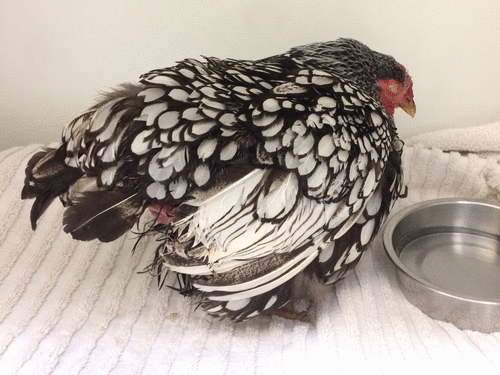
Butorphanol combined with midazolam has shown to be an effective premedicant in some species (Kubiak, Citation2016b).
Peregrine falcon showing wing drop. On admission it received butorphanol, and on examination and x-rays, it was discovered to be a soft tissue injury. The patient was started on oral meloxicam and tramadol. This bird always positioned itself with its good wing towards us and its damaged wing away from us (guarding/ self preservation behaviour).
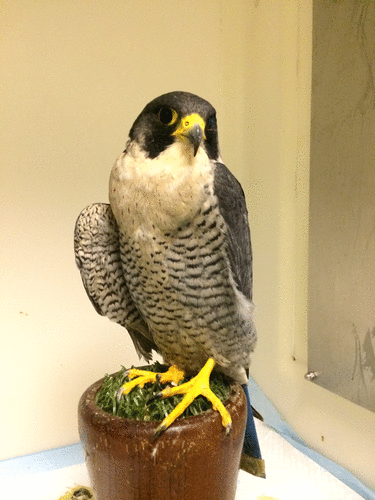
Tramadol, which works centrally as a μ-receptor agonist and peripherally to inhibit serotonin and norepinephrine reuptake, has shown some success in avian pain studies.
Conure with a beak fracture on the lower right hand side. The patient had been unable to eat for some time and was weak, dehydrated and painful. He presented on the bottom of his cage, fluffed up, closing his eyes and very quiet. This photo was taken after initial treatment of opioid analgesia, warmth, SC fluids and crop feeding. Following rehydration the bird was started on meloxicam.
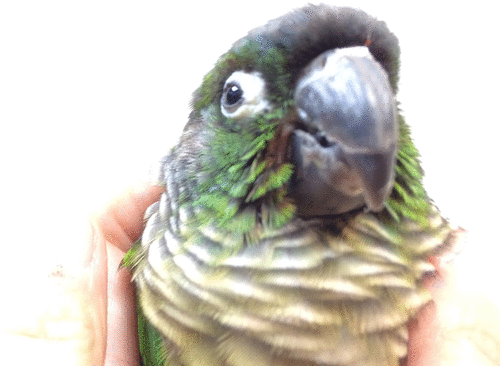
Non-steroidal anti-inflammatories
The inflammatory response is similar to mammals (Nicol, Klingberg, & Vasko, Citation1992) and although research in NSAIDs has been variable, which may be due to dose or species variation, there are NSAIDs that have been proven to be effective. Commonly used NSAIDs include meloxicam and carprofen. The same considerations with NSAID use are with birds as with mammals; caution should be taken when regarding GI conditions, hypo-perfusion or hypotension, and hepatic/renal function.
Local anaesthesia
Local block drugs such as lidocaine and bupivacaine can be administered, if utilised carefully, as birds seem particularly sensitive to the side effects. Local anaesthesia is usually not recommended to be used in a conscious bird, as happens with minor procedures in humans or large animals, because the stress of handling and restraint will be detrimental (Paul-Murphy & Hawkins, Citation2011). Lidocaine infiltration is a regular protocol used in crop surgery and bumblefoot surgery at the British Hen Welfare Trust (Marcella Pervesi, personal communication).
Challenges in research – early days
As knowledge is still limited, we can only do what we can with regards to assessing and treating pain in birds. Pain behaviours in birds can be very cryptic and subtle, and they do not always manifest uniformly among different species, breeds or even among individuals.
To highlight the scale of research required, we can think about this: as nurses we are all familiar with pain behaviours that vary between individual dogs that we know, or between different breeds of dogs – and this is only within one species (Canis familiaris). Research so far, shows that most of Canis familiaris respond to the same analgesic drugs, with very minor variation between breeds and individuals.
In contrast, there are around 10,000 known species of birds, with about 200 of those species kept as pets. Within each pet species there may be different breeds. Each species has a different range of behaviour and different pharmacokinetic and pharmacodynamic responses to different drugs (Paul-Murphy & Hawkins, Citation2015). This is not even considering different breeds. This is a significant challenge in research.
Table outlines some of the main pain behaviours that have been researched so far.
Despite the evidence we have, it must be remembered that the pain behaviours listed are often specific for the procedures detailed in each of the studies. Therefore, we can only use them as a part of a holistic assessment of our avian patients. Table shows some common analgesics used in practice.
Table 2. Basic analgesia doses in birds
In conclusion, this article provides a brief overview of pain behaviours in birds. It discusses the importance of being able to recognise avian pain, but accepts there is a difficulty in doing so. It recognises that there is an urgent need for ongoing pharmacokinetic and dose–response studies of drugs commonly used in avian analgesia, otherwise it will continue to be limited by anecdotal information and clinical judgement (Ludders & Matthews, Citation2007).
If there is tissue damage, or suspected tissue damage, and the bird is exhibiting changes in normal posture, temperament or behaviour, the veterinarian should assume the bird is experiencing pain (Jenkins, Citation1993). Until species and procedure-/context-specific pain scales are established, if we do not know whether the bird is in pain, it may be fair to give the animal benefit of the doubt and administer pain relief. The old adage “if it would hurt me, it would hurt my patient” is always a good guide.
The authors would like to thank Vale Wildlife Rescue, The British Hen Welfare Trust, Victoria Estacio-Flores, Michelle Hawkins and Joe Hills for their help with this article.
Some information on the British Hen Welfare Trust:
The British Hen Welfare Trust was founded in 2005 to rehome laying hens from the Battery system; 50,000 hens per year are found pet homes where they live out their retirement in a free-range environment. Hens are rehomed from 32 collection points around the UK staffed by 500 volunteers. The charity’s ultimate aim is to see consumers and food manufacturers buying only UK-produced free-range eggs, resulting in a strong British egg industry where all commercial laying hens enjoy a good quality of life.
Multiple Choice Questions
| 1. | Which of the following physiological parameters would commonly be associated with acute pain in birds?
| ||||||||||||||||||||||||||||
| 2. | Which of the following changes in temperament or personality could indicate pain in a bird?
| ||||||||||||||||||||||||||||
| 3. | Which opioid pain receptor is predominate in the forebrain of avian species?
| ||||||||||||||||||||||||||||
| 4. | Which of the following opioids is an agonist at K- receptors?
| ||||||||||||||||||||||||||||
| 5. | The article suggests which combination of drugs may be an effective premedicant in some avian species?
| ||||||||||||||||||||||||||||
| 6. | What percentage of experimental procedures carried out in the UK in 2016 are believed to have involved birds?
| ||||||||||||||||||||||||||||
| 7. | Farming is the biggest issue concerning avian pain:
| ||||||||||||||||||||||||||||
| 8. | It is estimated that how many wild birds are bought home by cats every year in the UK?
| ||||||||||||||||||||||||||||
For the answers to the MCQs, please go to: http://www.bvna.org.uk/publications/veterinary-nursing-journal
Additional information
Notes on contributors

Aneesa Malik
Aneesa has worked in first-opinion practice, emergency, referral and for the RSPCA. She went on to pursue an interest in animal welfare science, particularly pain assessment and management. Her focus is the factors that affect very different pain management regimes in our veterinary patients.
Email: [email protected]
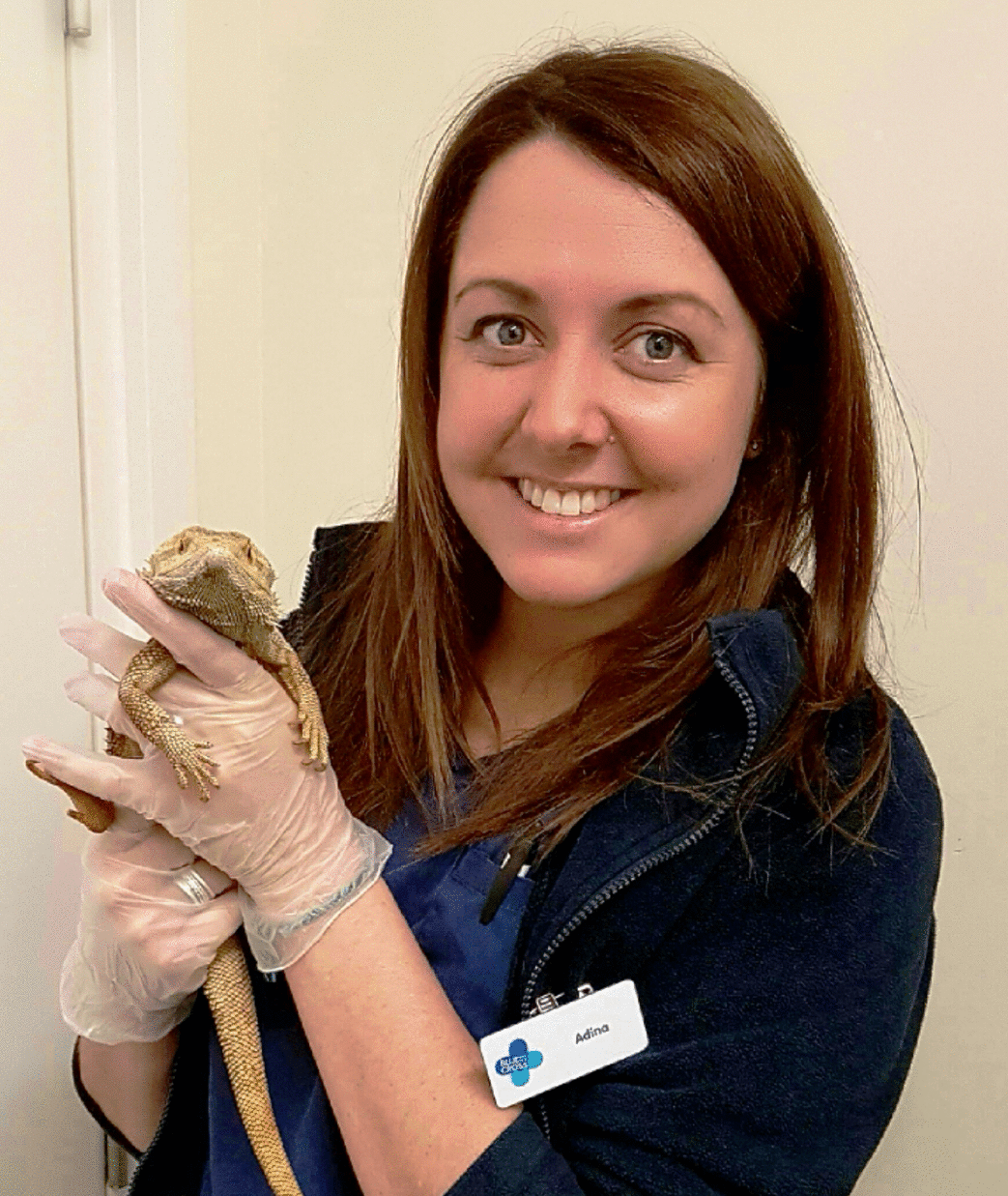
Adina Valentine
Adina started working in private practice in 2004 dealing with exotic species; once qualified as an RVN she started travelling abroad, working for animal welfare charities across the UK and Asia.
Adina is a committee member for the Association of Zoo and Exotic Veterinary Nurses (AZEVN), a clinical coach to student veterinary nurses and is currently studying towards a Diploma in Animal Ethics and Welfare.
Adina works for the Blue Cross Animal Hospital in North East Lincolnshire.
Email: [email protected]
References
- Buchwalder, T., & Huber-Eicher, B. (2005). Effect of the analgesic butorphanol on activity in turkeys (Meleagris galloparvo). Research in Veterinary Science, 79, 239–244.10.1016/j.rvsc.2004.11.013
- Carpenter, J. W., & Marion, C. J. (2013). Exotic animal formulary (4th ed.). St. Louis, MO: Elsevier.
- Danbury, T. C., Weeks, C. A., Waterman-Pearson A. E., Kestin S. C., & Chambers J. P. (2000). Self-selection of the analgesic drug carprofen by lame broiler chickens. Veterinary Record, 146, 307–311.10.1136/vr.146.11.307
- Debut, M., Berri, C., Arnould, C., Guemené, D., Santé-Lhoutellier, V., Sellier, N., … Le Bihan-Duval E. (2005). Behavioural and physiological responses of three chicken breeds to pre-slaughter shackling and acute heat stress. British Poultry Science, 46, 527–535.10.1080/00071660500303032
- Desmarchelier, M., Troncy, E., Beauchamp, G., Paul-Murphy, J. R., Fitzgerald, G., & Lair, S. (2012). Evaluation of a fracture pain model in domestic pigeons (Columba livia). American Journal of Veterinary Research, 73, 353–360.10.2460/ajvr.73.3.353
- Desmarchelier, M., Troncy, E., Fitzgerald, G., & Lair, S. (2012). Analgesic effects of meloxicam administration on post-operative orthopaedic pain in domestic pigeons (Columba livia). American Journal of Veterinary Research, 73, 361–367.10.2460/ajvr.73.3.361
- Forbes, N. (1999) Birds, in anaesthesia and analgesia of exotic species (Ch. 27). In C. Seymour, & R. Gleed (Eds.), BSAVA manual of small animal anaesthesia and analgesia (pp. 283–293). Cheltenham: BSAVA.
- Gentle, M. J. (1992). Pain in birds. Animal Welfare, 1, 235–247.
- Gentle, M. J., & Tilston, V. (2000). Nociceptors in the legs of poultry: Implications for potential pain in pre-slaughter shackling. Animal Welfare, 9, 227–236.
- Gentle, M. J., Tilston, V., & McKeegan, D. E. F. (2001). Mechano-thermal nociceptors in the scaly skin of the chicken leg. Neuroscience, 106, 643–652.10.1016/S0306-4522(01)00318-9
- Girling, S. J. (2013) Veterinary nursing of exotic pets (2nd ed.). Chichester: Blackwell Publishing.10.1002/9781118782941
- Gustavsen, K. A., Guzman, D. S., Knych, H. K., Petritz, O. A., Olsen, G. H., & Paul-Murphy, J.R. (2014). Pharmacokinetics of buprenorphine hydrochloride following intramuscular and intravenous administration to American kestrels (Falco sparverius). American Journal of Veterinary Research, 75, 711–715.10.2460/ajvr.75.8.711
- Sanchez-Migallon Guzman, D. S. M., Souza, M. J., Braun, J. M., Cox, S. K., Keuler, N. S., & Paul-Murphy, J. R. (2012). Antinociceptive effects after oral administration of tramadol hydrochloride in Hispaniolan Amazon parrots (Amazon ventralis). American Journal of Veterinary Research, 73, 1148–1152.10.2460/ajvr.73.8.1148
- Guzman, D. S. M., Drazenovich, T. L., Olsen, G. H., Willits, N. H., & Paul-Murphy, J. R. (2014). Evaluation of thermal anti-nociceptive effects after oral tramadol hydrochloride to American Kestrels (Falco sparverius). American Journal of Veterinary Research., 75, 117–123.10.2460/ajvr.75.2.117
- Hawkins, M. G. (2006). The use of analgesics in birds, reptiles, and small exotic mammals. Journal of Exotic Pet Medicine, 15, 177–192.10.1053/j.jepm.2006.06.004
- Hawkins, M. G., & Paul-Murphy, J. (2011). Avian analgesia. Veterinary Clinics of North America: Exotic Animal Practice., 14, 61–80.
- Herling, S., Coale, E. H., Valentino, R. J., Hein, D. W., & Woods, J. H. (1980). Narcotic discrimination in pigeons. The Journal of Pharmacology and Experimental Therapeutics, 214, 139–146.
- Hocking, P. M., Gentle, M. J., Bernard, R., & Dunn, L. N. (1997). Evaluation of a protocol for determining the effectiveness of pre-treatment with local analgesics for reducing experimentally induced articular pain in domestic fowl. Research in Veterinary Science, 63, 263–267.10.1016/S0034-5288(97)90031-X
- Hocking, P. M., Robertson, G. W., & Gentle, M. J. (2005). Effects of non-steroidal antiinflammatory drugs on pain-related behaviour in a model of articular pain in the domestic fowl. Research in Veterinary Science, 78, 69–75.10.1016/j.rvsc.2004.05.005
- Home Office Data. (2016). Retrieved from www.gov.uk/government/uploads/system/uploads/attachment_data/file/627284/annual-statistics-scientific-procedures-living-animals-2016.pdf
- Jenkins, J. R. (1993). Post-operative care of the avian patient. Seminars in Avian and Exotic Pet Medicine, 2, 97–102.
- Kubiak, M. (2016a). Avian analgesia. Companion Animal, 21, 480–484.10.12968/coan.2016.21.8.480
- Kubiak, M. (2016b). The influence of combined butorphanol and midazolam premedication on anaesthesia in Psittacid species. Journal of Avian Medicine and Surgery, 30, 317–323.10.1647/2013-072
- Lierz, M., & Korbel, R. (2012). Anaesthesia and analgesia in birds. Journal of Exotic Pet Medicine, 21, 44–58.10.1053/j.jepm.2011.11.008
- Ludders J. W., & Matthews N. S. (2007) Birds (Ch. 34). In W. J. Tranquilli, J. C. Thurmon, & K. A. Grimm (Eds.), Lumb and Jones veterinary anaesthesia and analgesia (4th ed., pp. 841–868). Oxford: Blackwell Publishing.
- Machin, K. L. (2005). Avian analgesia. Journal of Exotic Pet Medicine, 14, 236–242.10.1053/j.saep.2005.09.004
- Machin K. L. (2014) Recognition and treatment of pain in birds. In C. M. Egger, L. Love, & T. Doherty (Eds.), Pain management in veterinary practice (Ch. 37, pp. 407–415). Oxford: Wiley-Blackwell, John Wiley & Sons.
- Machin, K. L., & Livingston, A. (2002). Assessment of the analgesic effects of ketoprofen in ducks anaesthetized with isofluorane. American Journal of Veterinary Research., 63, 821–826.10.2460/ajvr.2002.63.issue-6
- McGeown, D., Danbury, T. C., & Waterman-Pearson A. E., Kestin S. C. (1999). Effect of carprofen on lameness in broiler chickens. Veterinary Record, 144, 668–671.10.1136/vr.144.24.668
- Mellor, D. J., & Bayvel, A. C. D. (2011). The scientific assessment of animal welfare. First OIE global conference on evolving veterinary education for a safer world. Paris, France, pp. 167–174.
- Meredith, A., (2015). BSAVA small animal formulary. 9th Ed., Part B: Exotics. Gloucester: BSAVA.
- Miesle, J. (2017). Part nine: Avian pain management – Pain assessment in birds. Retrieved from www.beautyofbirds.com/part9avianpainmanagementqualityoflife
- Nasr, M. A. F., Browne, W. J. M., Caplen, G., Hothersall, B., Murrell, J. C., & Nicol, C. J. (2013). Positive affective state induced by opioid analgesia in laying hens with bone fractures. Applied Animal Behaviour Science, 147, 127–131.10.1016/j.applanim.2013.04.015
- Nasr, M. A. F., Murrell, J., Wilkins, L. J., & Nicol, C. J. (2012a). The effect of keel fractures on egg-production parameters, mobility and behaviour in individual laying hens. Animal Welfare, 21, 127–135.10.7120/096272812799129376
- Nasr, M. A. F., Nicol, C. J., & Murrell, J. (2012b). Do laying hens with keel bone fractures experience pain? PLoS ONE, 7, 1–6, e42420. doi:10.1371/journal.pone.0042420
- Nasr, M. A. F., Nicol, C. J., Wilkins, L., & Murrell, J. (2015). The effects of two non-steroidal anti-inflammatory drugs on the mobility of laying hens with keel bone fractures. Veterinary Anaesthesia and Analgesia, 42, 197–204.10.1111/vaa.12175
- Nicol, G. D., Klingberg D. K., & Vasko, M. R. (1992). Prostaglandin E2 increases in calcium conductance and stimulates the release of substance P in avian sensory neurons. Journal of Neuroscience, 12, 1917–1927.
- Pablo L. S. (2002). Avian anaesthesia. In S. A. Greene (Eds.), Veterinary anaesthesia and pain management secrets (Ch. 46, pp. 275–282). Philadelphia: Hanley and Belfus.10.1016/B978-1-56053-442-6.50049-8
- Paul-Murphy J. R., Brunson D. B., & Miletic V. (1999). Analgesic effects of butorphanol and buprenorphine in conscious African Grey parrots (Psittacus erithacus and Pstittacus erithacus timneh). American Journal of Veterinary Research, 60, 1218–1221.
- Paul-Murphy, J. R. (2006). Pain management. In G. J. Harrison, & T. Lightfoot (Eds.), Clinical avian medicine (Ch. 8, pp. 1–7). Rumford, ME: Spix Publishing, Irish Booksellers.
- Paul-Murphy J. R., & Hawkins M. G. (2011). Avian analgesia. Veterinary Clinics Exotic Animals, 14, 61–80.10.1016/j.cvex.2010.09.011
- Paul-Murphy, J. R., & Hawkins, M. G. (2015). Bird specific considerations: Recognizing pain behaviour in pet birds. In J. S. Gaynor & W. W. Muir (Eds.), Handbook of veterinary pain management (3rd ed., Ch. 26, pp. 536–554), St. Louis, MO: Elsevier.10.1016/B978-0-323-08935-7.00026-0
- RSPB. (2017). Retrieved from www.rspb.org.uk/get-involved/community-and-advice/gardenadvice/\unwantedvisitors/cats/birddeclines.aspx
- Wathes, C. (2009). Retrieved from www.fao.org/fileadmin/user_upload/animalwelfare/FAWC%20Report_white_meat__1.pdf
- Weary, D. M., Niel, L., Flower, F. C., & Fraser, D. (2006). Identifying and preventing pain in animals. Applied Animal Behaviour Science, 100, 64–76.10.1016/j.applanim.2006.04.013
- Weeks, C. A., Danbury, T. D., Davies, H. C., Hunt, P., & Kestin, S. C. (2000). The behaviour of broiler chickens and its modification by lameness. Applied Animal Behaviour Science, 67, 111–125.10.1016/S0168-1591(99)00102-1
- White, E. (2016). Veterinary technicians can play vital role in improving pain control. American Veterinarian News. Retrieved from www.americanveterinarian.com/news/vettechnicians-can-play-vital-role-in-improving-pain-control

